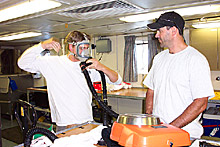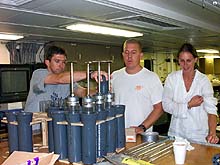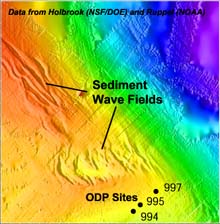
Alvin pilot Bruce Strickrott discusses the EBA with members of the science party scheduled to dive in Alvin. Click image for larger view.
Slow Start out of the Gate: Learning the Dance of the Waves
July 23, 2003
Dr. Carolyn Ruppel, Co-Chief Scientist
Associate Professor
Georgia Institute of Technology
Taconya Piper, NOAA Office of Ocean Exploration
Nearly 48 hours after departure from Woods Hole, many members of the science party are still recovering from seasickness, while others seem to have quickly gained their “sea legs.” The weather has not been at all kind or cooperative with us as we ran through a white squall (a sudden, strong gust of wind coming up without warning) off the coast of North Carolina this morning, causing many to remain sick and others to become sick.
Merely walking around on the R/V Atlantis remains difficult. Although the first DSV Alvin dive is not expected to occur until Friday, dive preparations have already begun. Members of the science team who are scheduled to dive have attended an orientation with the Alvin pilots and have been fitted for their EBA (emergency breathing apparatus) in case of emergency in the Alvin. Meanwhile, other members of the science team assembled push cores in preparation for the dives.

Students Rachael Horak, Bill Gilhooly, Heath Mills, and Taylor Heyl assemble push cores in preparation for the Alvin dives. Click image for larger view.
The first science meeting occurred this afternoon in the ship's library. Science meetings will be held each afternoon to review the previous day's dive findings and the results of the previous night's bathymetric and subbottom surveys. Science Collaborator Dr. W. Steven Holbrook presented the results of an intensive high-resolution seismic program conducted on the Blake Ridge aboard the R/V Ewing with NSF and DOE support in Autumn 2000, and he discussed the origin of the so-called "Blake Ridge Depression." This feature, which had previously been interpreted as a large seafloor collapse associated with massive, rapid methane expulsion (a "burp" of methane) from the seafloor, is now believed to be similar to a field of sand dunes deposited by ocean currents.

This bathymetry map reveals two sediment wave fields on the Blake Ridge. Click image for larger view.
The distribution of gas in the sediments beneath the Blake Ridge Depression is very complicated, with gas missing in some areas and present in the shallow sediments just beneath the seafloor in other areas. After much discussion, the scientists chose the first dive site on the northeastern flank (side) of the Blake Ridge, where erosional processes have exposed older sediments and may have permitted gas to escape. During the first dive, the scientists will study the older exposed rocks, look for methane seeps, explore the seafloor for signs of past or present chemosynthetic communities, and sample sediments to determine their age and to constrain the chemistry of water trapped in sediment pores.
The weather report for tomorrow looks very promising. We hope for calm winds and seas to greet us as we approach our first dive site.


















